ESJ Scholars’ End-of-Semester Pecha Kucha Address Social Justice Issues in Engineering
May 23, 2017

Illinois Engineering for Social Justice Scholars from left to right: Kendall Furbee, Cheyenne Syring,
Mrinaal Mittal.
To showcase their final projects related to social justice issues they’re passionate about, eleven engineering undergrads who were part of the pilot for the new, two-semester-long Engineering for Social Justice (ESJ) Scholars program presented Pecha Kucha in an end-of-the-semester event. (In this Japanese presentation style, 20 slides are shown for 20 seconds each, keeping presentations by multiple speakers concise and fast paced). On hand to witness the May 8 final event, were a number of interested Engineering administrators, faculty, and members of the Illinois community.
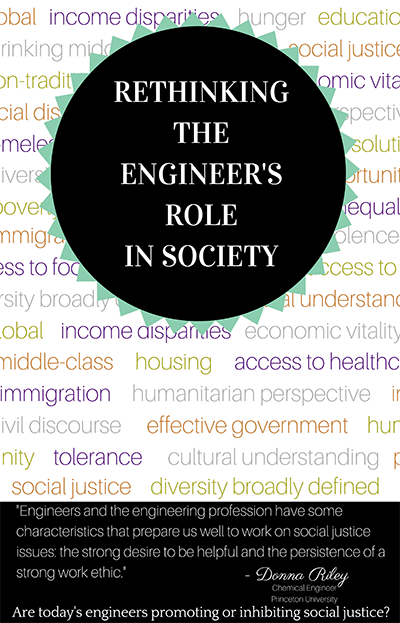
One of ESJ scholar Cheyenne Syring's "What is an Engineer?" poster collection,
which was posted on the 2nd floor of Engineering Hall in May.
Created by Engineering’s Outreach Coordinator, Sahid Rosado, and Valeri Werpetinski, Director of Learning in Community (LINC), Engineering’s service learning program, the ESJ Scholars program was designed to help Illinois Engineering students understand that social justice is an engineering issue and to rethink the role engineers play in society.
In the second course of the two-semester program, "Leadership in Engineering for Social Justice," students were to draw from everything they’d learned in the fall course and as mentors in ICANEXSEL (Illinois-ChiS&E Alliance for Nurturing Excellence in STEM Education Leadership), an outreach to diverse, Chicago Public School (CPS) middle school students. In the first part of the semester, they participated in local STEM education outreach. After creating their own lesson plans, they "engaged underrepresented youth in Champaign-Urbana in STEM education outreach activities in collaboration with local community partners, DREAAM House, St. Elmo Brady STEM Academy, and Don Moyer Boys & Girls Club," Werpetinski explains. For their final project, they were to choose something they feel passionate about, such as an issue that’s happening on campus or locally, and come up with a program to address it.
Rosado hopes the students' projects "will help the campus community think differently about our campus and reflect on their own role within it. I hope that by seeing their presentations and their projects at work, people can start to think and realize that they too can work towards a socially just community, even if it's with something that seems like a small action or initiative.
Rosado also hopes the projects can specifically impact current engineering students: I hope that these projects can help them understand that engineering must not (and cannot) be seen as a field that is completely disconnected from social justice principles."

Another poster from Cheyenne Syring's "What is an Engineer?" poster collection.
Projects were proactive in trying to foster change about a number of campus and community issues. For example, Cheyenne Syring’s presentation, “What is an Engineer?” addressed the role of women, the need for human-centered design, the harmful engineering mindset, and the role of Non-Western cultures. Her goal was: “to create an open dialogue to challenge society’s convention of the role of an engineer.” So she displayed posters on the 2nd floor of Engineering Hall.
Syring’s message to students was: “Recognize your privilege, and use it to fight for those who lack a voice society chooses to hear. As engineers, we cannot only look at the technical side of things and ignore our moral obligations to the fellow man. It’s inhumane to ignore an issue just because it doesn’t pertain to you specifically. The world is not a strict dichotomy of us vs. them, and progress can be made at a faster rate once we all realize we’re on the same team.”
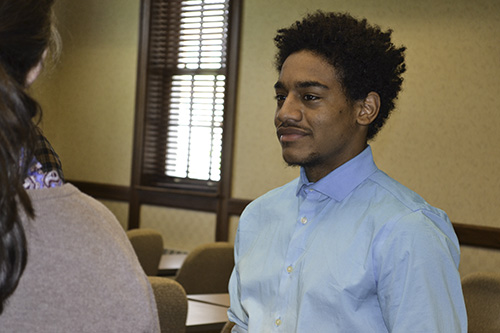 Above: Illinois Engineering for Social Justice Scholar, Amire Woolfolk chats after the Pecha Kucha.
Above: Illinois Engineering for Social Justice Scholar, Amire Woolfolk chats after the Pecha Kucha.Below: The ESJ YouTube Channel

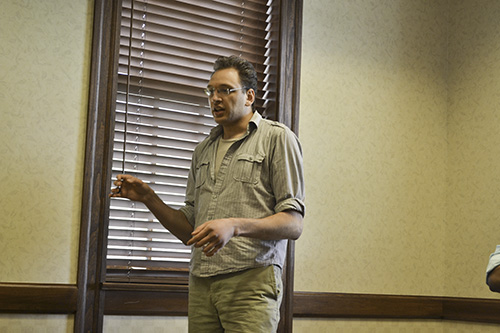
Illinois Engineering for Social Justice Scholar, Hani Awni
Another ESJ Scholar, Amire Woolfolk, created the ESJ Project YouTube channel, which deals mostly with areas of social justice in engineering, and includes videos of the social justice projects done by his classmates, as well as opportunity for others to contribute.
“I focus this simply toward engineers," says Woolfolk, "seeing as though we typically, in the field, ignore the problems of engineers in society in what we contribute, as well as what we could do to fix those problems.”
Also providing web-based resources, Hani Awni developed the Eng4SJ Project Proposal Repository. His goal was to enable future engineering students in senior design project courses to “start from a solid social-justice-oriented project proposal.” According to Awni, “Due to a lack of social justice content in engineering education, even engineering students interested in social justice reach their senior year without sufficiently complex understanding of societal dynamics to enable effectively addressing problems of interest.”
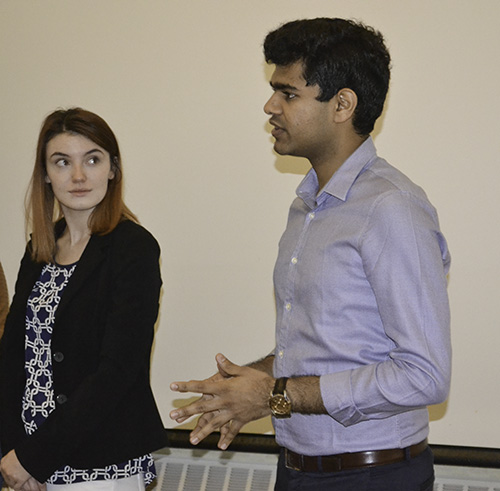
Illinois Engineering for Social Justice Scholars Cheyenne Syring and Mrinaal Mittal
Addressing the issue of gender discrimination in STEM, Mrinaal Mittal presented his project, “Sexism in STEM: It’s a Men’s Issue,” which was a World-Café-style event at the Beckman Institute where faculty, administrative staff, and students got together to talk about issues related to sexism. Mittal indicates that his purpose was to “create a more equitable environment on UIUC campus specially related to gender discrimination,” by holding an event “targeted towards men so that they get a chance to learn about the difference they can make at an individual level and in the system.”
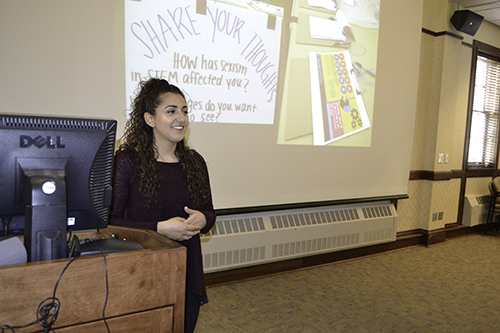
Illinois ESJ Scholar, Angel Loizzo
Also seeking to address the dearth of women in the STEM fields, Angel Loizzo presented her project entitled “Why so Chilly for Women in STEM?” Citing some chilling statistics (26% of the current computing workforce is women, and 50% leave their STEM careers within the first 10 years), Loizzo addresses some types of subtle discrimination that can impact the number of women who end up in STEM fields, like Stereotype Threat, Unconscious Bias, and the Double Bind theory.
"The chilly climate metaphor represents the accumulation of subtle discrimination and sexism that saturates the STEM work environment and education settings." View Loizzo's presentation here.
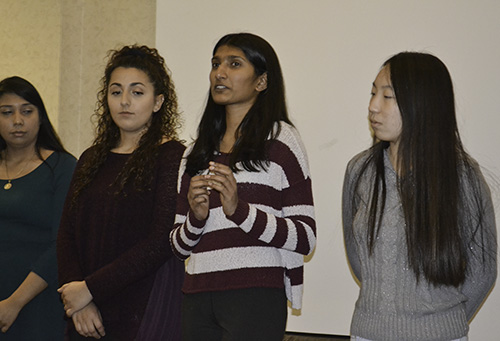
Illinois Engineering for Social Justice Scholar, Punami Chowdary
According to Punami Chowdary, another ESJ scholar, “Engineers are not introduced to career opportunities in which they can apply their engineering skills to make a social impact.” So Chowdary sought to develop a framework for programs/ initiatives the Engineering Career Center can implement next semester to help Illinois Engineering students do so. Proposed projects included: an educational workshop to help students understand how Engineering and Social justice intersect, and a small-scale networking event the day before the Engineering Career Fair.
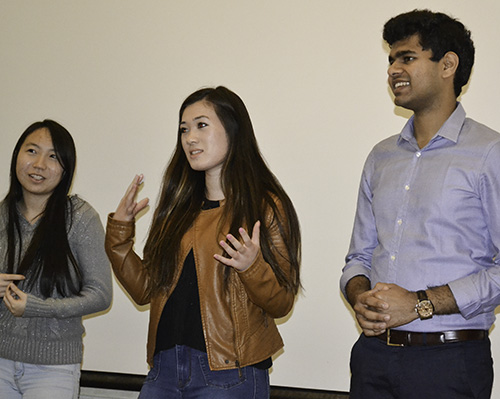
Illinois Engineering for Social Justice Scholar, Kendall Furbee
Seeking to increase the number of female entrepreneurs at Illinois, Kendall Furbee proposed the following programs/activities. She proposes the first four, which lead up to the Cozad New Venture Competition, in an effort to get more women participating in the contest.
- A Girl Power pitch night
- Women Entrepreneur of the Year Award
- “Dolphin Tank”
- 4-week business development workshops catered to women.
- Improve marketing of startup culture at Illinois, (i.e., more pictures with women)
- Website to expose successful Illinois, women-led startups.
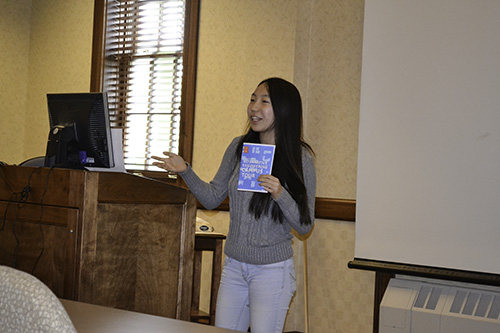
Illinois Engineering for Social Justice Scholar, Somie Park
Somie Park’s project was an Alternative Tour of Engineering Campus. She says that it “shows the struggles normally not seen due to other more positive narratives of the College, and link these struggles to larger social justice issues by questioning the spaces that are inhabited and thinking more critically about the implications of things like corporate influence on the University.” So she created a self-guided tour booklet, which will soon be available publicly, dealing with the following topics: corporate influence, accessibility, community, and ethics. Throughout the tour, questions are posed to stimulate thinking about the institutional social injustice that has taken place on campus.
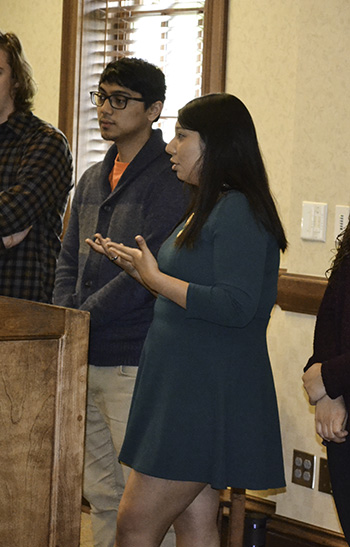
Illinois Engineering for Social Justice Scholar, Ana Artiaga
Ana Artiaga’s project, Inspiración for Latinx Students: Community Art as Social Action in STEM, was “the creation of an art piece to educate people about the value of minorities in higher education, especially in STEM. An art piece adds visibility and encouragement for viewers, opposite of a hidden curriculum. Using community art to create a narrative around a space and visibility of people is a powerful proposal.” So Artiaga is doing just that. She worked with Urbana Middle School Teachers, Ms. Maria Moreno (ELL/Bilingual Social Studies Teacher) and Ms. Darienne Ciuro Sanchez (ELL/Bilingual Science Teacher), on afterschool workshops with Latinx youth to discuss issues of identity and labeling and to generate ideas for a community mural which would depict a positive narrative about the students’ goals and how they see themselves. Plus, she is working with a Latino artist, Frank Vega (Fine & Applied Arts student at Illinois) to plan the mural for Urbana Middle School, and pending approval, Frank will engage the youth in the production of the mural in May.
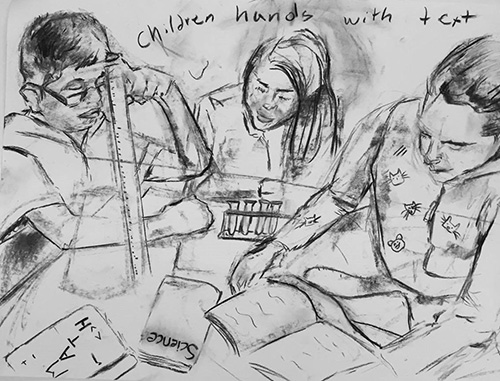
An early draft of Frank Vega's mural to be painted at the Urbana Middle School as part of Ana Artiaga's project.
Ryan Gilmore’s project, “Advancing Justice with the Siebel Center for Design,” sought to incorporate social justice into the principles of Human-Centered Design for Users by adapting it to communities. Gilmore used inspiration from the principles of design for social justice to propose ideas and create resources that could be used in programming for the Siebel Center for Design. He shared some of his ideas with faculty and staff at the Entrepreneurship Forum..
Jake Navarez’s project, “Ethics in Engineering,” was related to engineering ethics. According to Navarez, "After taking this class, I feel like I have a better understanding of the relationship between social justice and engineering. Not only that, but the relationship between social justice and education as well. As a future educator, this class has taught me how to view and help communities that I might work for in the future.”
What kind of overall impact did the course have on the students? Werpetinski reports being "encouraged by changes we’ve already witnessed in the students’ overall knowledge about social justice issues, enhanced critical thinking about engineering’s role in promoting or inhibiting social and environmental justice, and shifts in previously unquestioned values, attitudes, and dispositions. Some of the students have really embraced the opportunity to impact their spheres of influence this year—whether that be within their peer networks, various university settings, or the broader community.
She also reports that involvement in the ESJ Scholars Program has already significantly influenced several students' future plans in significant ways.
For example, one student changed his grad school plans to continue to explore social justice-oriented research pursuits. Another accepted a summer internship in Washington, DC under the Congressional Hispanic Caucus Institute, an internship which Werpetinski says, "she would not have considered previously with her bounded understanding of the role of engineers and their potential contributions to policy or government work."
She adds that "Still others have declared their intentions to build on their “Engineering for Social Justice Projects” in the upcoming school year, to continue STEM education outreach work with underrepresented students, and to apply their learning in the ESJ Scholars Program to other roles that they hold in registered student organizations.
Story and photographs by Elizabeth Innes, Communications Specialist, I-STEM Education Initiative.
For additional related I-STEM web articles, see:
- Engineering for Social Justice Scholars Program Helps Students Rethink Engineering's Role in Society
- Student Spotlight: Hani Awni–Engineering for Social Justice Scholar
More: Engineering,Graduate Education Reform, Underserved Minorities, Undergraduate Education Reform, 2017
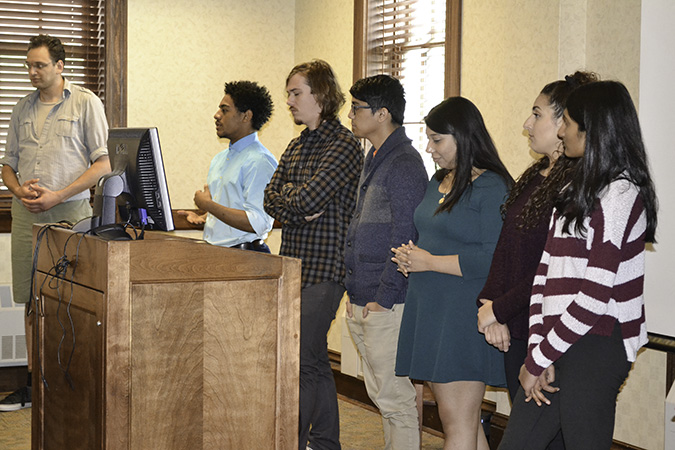
The Illinois ESJ Scholars participate in a question-and-answer period following their presentations.













.jpg)
















